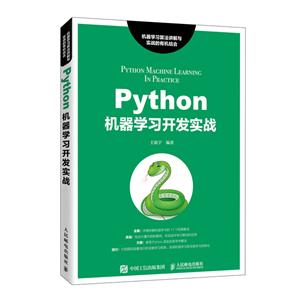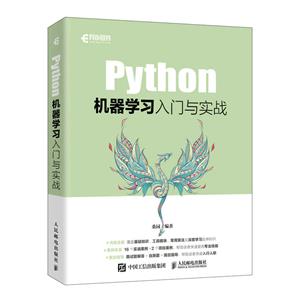
作者:(美)克里斯·阿尔本(ChrisAlb
页数:349
出版社:东南大学出版社
出版日期:2018
ISBN:9787564179786
电子书格式:pdf/epub/txt
内容简介
《Python机器学习经典实例(影印版)(英文版)》这本实用指南提供了近200则完整的攻略,可帮助你解决日常工作中可能遇到的机器学习难题。如果你熟悉Python以及包括pandas和scikit—learn在内的库,那么解决一些特定问题将不在话下,比如数据加载、文本处理、数值数据、模型选择、降维以及诸多其他主题。
每则攻略中都包含代码,你可以将其复制并粘贴到实验数据集中,以确保代码的确有效。你可以插入、组合、修改这些代码,从而协助构建你自己的应用程序。攻略中还包括相关的讨论,对解决方案给出了解释并提供有意义的上下文。克里斯·阿尔本著的《Python机器学习经典实例(影印版)(英文版)》在理论和概念之外提供了构造实用机器学习应用所需的具体细节。
作者简介
克里斯·阿尔本,是肯尼亚创业公司BRCK的首席数据科学家。他此前创立了AI公司New。
目录
Preface
1. Vectors, Matrices, and Arrays
1.0 Introduction
1.1 Creating a Vector
1.2 Creating a Matrix
1.3 Creating a Sparse Matrix
1.4 Selecting Elements
1.5 Describing a Matrix
1.6 Applying Operations to Elements
1.7 Finding the Maximum and Minimum Values
1.8 Calculating the Average, Variance, and Standard Deviation
1.9 Reshaping Arrays
1.10 Transposing a Vector or Matrix
1.11 Flattening a Matrix
1.12 Finding the Rank of a Matrix
1.13 Calculating the Determinant
1.14 Getting the Diagonal of a Matrix
1.15 Calculating the Trace of a Matrix
1.16 Finding Eigenvalues and Eigenvectors
1.17 Calculating Dot Products
1.18 Adding and Subtracting Matrices
1.19 Multiplying Matrices
1.20 Inverting a Matrix
1.21 Generating Random Values
2. Loading Data
2.0 Introduction
2.1 Loading a Sample Dataset
2.2 Creating a Simulated Dataset
2.3 Loading a CSV File
2.4 Loading an Excel File
2.5 Loading a ]SON File
2.6 Querying a SQL Database
3. Data Wrangling
3.0 Introduction
3.1 Creating a Data Frame
3.2 Describing the Data
3.3 Navigating DataFrames
3.4 Selecting Rows Based on Conditionals
3.5 Replacing Values
3.6 Renaming Columns
3.7 Finding the Minimum, Maximum, Sum, Average, and Count
3.8 Finding Unique Values
3.9 Handling Missing Values
3.10 Deleting a Column
3.11 Deleting a Row
3.12 Dropping Duplicate Rows
3.13 Grouping Rows by Values
3.14 Grouping Rows by Time
3.15 Looping Over a Column
3.16 Applying a Function Over All Elements in a Column
1. Vectors, Matrices, and Arrays
1.0 Introduction
1.1 Creating a Vector
1.2 Creating a Matrix
1.3 Creating a Sparse Matrix
1.4 Selecting Elements
1.5 Describing a Matrix
1.6 Applying Operations to Elements
1.7 Finding the Maximum and Minimum Values
1.8 Calculating the Average, Variance, and Standard Deviation
1.9 Reshaping Arrays
1.10 Transposing a Vector or Matrix
1.11 Flattening a Matrix
1.12 Finding the Rank of a Matrix
1.13 Calculating the Determinant
1.14 Getting the Diagonal of a Matrix
1.15 Calculating the Trace of a Matrix
1.16 Finding Eigenvalues and Eigenvectors
1.17 Calculating Dot Products
1.18 Adding and Subtracting Matrices
1.19 Multiplying Matrices
1.20 Inverting a Matrix
1.21 Generating Random Values
2. Loading Data
2.0 Introduction
2.1 Loading a Sample Dataset
2.2 Creating a Simulated Dataset
2.3 Loading a CSV File
2.4 Loading an Excel File
2.5 Loading a ]SON File
2.6 Querying a SQL Database
3. Data Wrangling
3.0 Introduction
3.1 Creating a Data Frame
3.2 Describing the Data
3.3 Navigating DataFrames
3.4 Selecting Rows Based on Conditionals
3.5 Replacing Values
3.6 Renaming Columns
3.7 Finding the Minimum, Maximum, Sum, Average, and Count
3.8 Finding Unique Values
3.9 Handling Missing Values
3.10 Deleting a Column
3.11 Deleting a Row
3.12 Dropping Duplicate Rows
3.13 Grouping Rows by Values
3.14 Grouping Rows by Time
3.15 Looping Over a Column
3.16 Applying a Function Over All Elements in a Column















